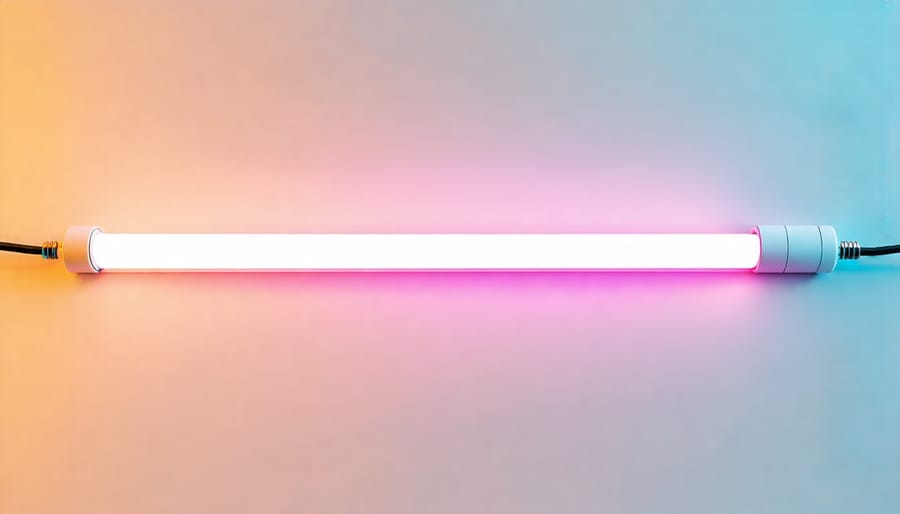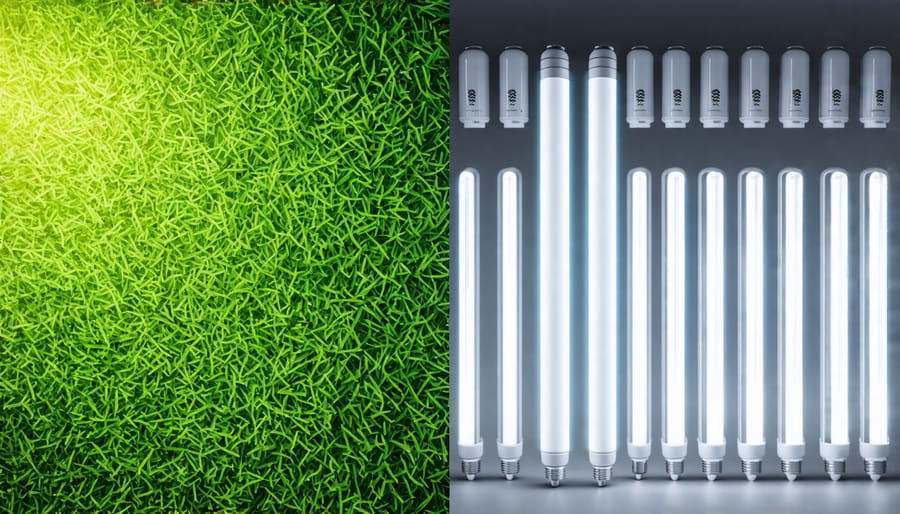Flickering, buzzing, and prematurely burning out – fluorescent lamps can be a constant source of frustration. As policymakers push for a fluorescent lamp phase-out, it’s crucial to understand the common issues plaguing these lighting fixtures and how to resolve them effectively. From ballast failure to incorrect wattage, this comprehensive guide dives deep into the root causes of fluorescent lamp problems and provides expert solutions to keep your lighting system running smoothly. Don’t let malfunctioning fluorescents disrupt your daily life or business operations – arm yourself with the knowledge to tackle these challenges head-on and ensure a well-lit, trouble-free environment.
Flickering and Blinking

Loose or Faulty Connections
Loose or faulty connections can cause flickering, dimming, or failure to start in fluorescent lamps. Check all connections, including those at the starter, ballast, and tombstones (lamp holders). Ensure that wires are securely fastened and not frayed or corroded. Tighten any loose connections and replace damaged components as needed. If the problem persists after checking and tightening connections, consult a professional electrician or lighting specialist to identify and resolve the issue. Proper maintenance and regular inspections can help prevent connection-related problems and extend the life of your fluorescent lighting system.
Aging Ballasts
As fluorescent ballasts age, they can exhibit signs of impending failure. Flickering or erratic lighting, buzzing or humming noises, and reduced light output are common indicators that a ballast is nearing the end of its lifespan. In some cases, the lamp may fail to light up at all. If you notice any of these symptoms, it’s crucial to replace the ballast promptly to prevent further damage and ensure optimal lighting performance.
Replacing a fluorescent ballast requires some electrical knowledge and safety precautions. First, disconnect the power to the fixture at the circuit breaker. Remove the lens cover and fluorescent tubes, then locate the ballast, which is typically housed in the fixture’s base. Carefully disconnect the wiring, noting the connections for proper reassembly. Install the new ballast, securing it in place and reconnecting the wires according to the manufacturer’s instructions. Finally, replace the fluorescent tubes and lens cover, and restore power to the fixture. If you are unsure about the process or encounter any difficulties, it is advisable to consult a professional electrician to ensure the job is done safely and correctly.
Buzzing Noises

Loose Components
Loose components within a fluorescent light fixture can cause flickering, buzzing, or failure to illuminate. To address this issue, first ensure the fixture is turned off and cooled down. Inspect the housing for any loose parts, such as sockets, ballasts, or reflectors. Tighten screws or bolts to secure these components. If any parts are damaged, replace them with manufacturer-approved alternatives. Ensure lamp pins are firmly seated in their sockets and not bent or corroded. By addressing loose components promptly, you can restore your fluorescent lamps to optimal performance and avoid potential safety hazards.
Ballast Issues
Noisy or humming ballasts are a common issue with fluorescent lamps. If you notice a loud buzzing sound coming from your fixture, it’s likely due to a failing ballast. Over time, the internal components can wear out, causing the ballast to vibrate and produce noise. In some cases, the ballast may overheat, posing a fire hazard. To troubleshoot, first ensure the lamp is properly seated and the fixture is clean. If the noise persists, the ballast should be replaced by a qualified electrician. Upgrading to a high-efficiency, low-noise electronic ballast can improve lamp performance and energy efficiency while minimizing annoying hums. Regular maintenance, such as cleaning the fixture and replacing lamps at the recommended intervals, can help extend the life of your ballast and prevent premature failure. If you’re unsure about replacing the ballast yourself, consult a professional lighting specialist to ensure the job is done safely and correctly.
Slow Starting
Low Ambient Temperatures
In low ambient temperatures, fluorescent lamps may experience difficulty starting or produce dim, flickering light. This is because the mercury vapor inside the lamp requires a minimum temperature to vaporize efficiently. To overcome this issue, consider using fluorescent lamps specifically designed for cold environments, which feature a special ballast that provides a higher starting voltage. Alternatively, you can install a “cold weather ballast” to help regular fluorescent lamps operate more effectively in chilly conditions. Positioning lamps away from cold air drafts and ensuring proper insulation can also help maintain the necessary operating temperature and prevent low-temperature-related problems.
Aging Lamps
As fluorescent lamps age, their light output decreases and they may exhibit slower starting times or flickering. This is due to the gradual deterioration of the tube’s electrodes and the depletion of the mercury vapor within the lamp. If you notice that your fluorescent tubes are taking longer to reach full brightness or are flickering more frequently, it’s a sign that they are nearing the end of their lifespan and should be replaced soon. While it’s possible to continue using these aging lamps, their diminished performance and increased energy consumption make replacement a more cost-effective solution in the long run. To maintain optimal lighting quality and energy efficiency, it’s recommended to replace fluorescent tubes every 12,000 to 20,000 hours of use, depending on the specific type and manufacturer’s guidelines. By proactively addressing aging lamps, you can ensure that your fluorescent lighting system continues to provide reliable, high-quality illumination.
Color Shifting
Color shifting in fluorescent lamps can be caused by several factors. One common cause is the age of the lamp; as fluorescent bulbs near the end of their lifespan, the phosphors coating the inside of the tube deteriorate, leading to changes in color output. Another reason for color shifts is the ambient temperature; if the surrounding environment is too cold, the lamp may appear more pink or red, while higher temperatures can cause a bluish hue.
To address color shifting issues, first check the age of your fluorescent lamps and replace any that are nearing or past their rated lifespan. Ensure that the ambient temperature in the room falls within the recommended range for your specific lamps; consult the manufacturer’s guidelines for optimal operating temperatures. If color consistency is crucial for your application, consider upgrading to higher-quality fluorescent lamps with better color rendering properties and more stable phosphors. In some cases, using a different type of lighting technology, such as LED, may provide more consistent color output over time. If you’re unsure about the best solution for your space, consult with a professional lighting designer who can assess your needs and recommend the most appropriate options.

Early Burnout
Incompatible Ballasts
Using incompatible ballasts with fluorescent lamps can lead to a variety of issues, such as poor light output, flickering, humming noise, or even failure to start. Each type of fluorescent lamp is designed to work with a specific ballast that provides the proper voltage and current. Pairing a lamp with the wrong ballast can result in suboptimal performance or damage to the components. To avoid these problems, always consult the manufacturer’s specifications and guidelines when selecting ballasts for your fluorescent lighting system. Ensuring compatibility between the lamps and ballasts will help maintain optimal light quality, energy efficiency, and longevity of your fixtures. If you’re unsure about the right combination for your needs, consider seeking advice from a professional lighting designer or electrician to ensure a seamless and reliable installation.
High Voltage Fluctuations
Voltage fluctuations can significantly impact the performance and longevity of fluorescent lamps. When the voltage supplied to a fluorescent lamp is too high, it can cause the lamp to overheat, leading to premature failure and reduced light output. To mitigate this issue, installing voltage regulators is a practical solution. These devices help maintain a stable voltage supply to the lamps, even in the presence of fluctuations from the power source. By keeping the voltage within the optimal range specified by the manufacturer, voltage regulators can extend the life of fluorescent lamps and ensure consistent lighting performance. Investing in quality voltage regulators is a smart choice for those looking to maximize the efficiency and durability of their fluorescent lighting systems.
Conclusion
In conclusion, while fluorescent lamps are a popular and efficient lighting choice, they can experience various issues that impact their performance and longevity. By understanding the common problems and their causes, such as flickering, buzzing, dimming, or failure to start, you can effectively troubleshoot and address these concerns. Regular maintenance, including proper cleaning and timely replacement of bulbs and ballasts, can prevent many of these issues from occurring. If you encounter persistent problems or require expert guidance for your lighting setup, consider reaching out to professional lighting design services. These specialists can provide tailored solutions and professional assistance to ensure your fluorescent lighting operates at its best, creating a well-lit and inviting environment for your home or business.





